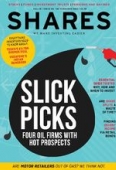Archived article
Please note that tax, investment, pension and ISA rules can change and the information and any views contained in this article may now be inaccurate.
Are share splits a waste of time?

Have you ever seen a share price automatically shoot up 1,000% or suddenly become a fraction of the price it was the previous day? If so, these are likely to be a result of a company undertaking a share split or share consolidation.
This can involve cutting the number of shares in issue to make the share price much higher. Or more shares are issued to automatically lower a share price and make it appear less expensive.
Many companies will tell you they’re trying to improve liquidity in the stock, making it easier for you to buy and sell.
In reality most are trying to make the share price seem more credible, affordable or repositioning themselves in the same price bracket as respected businesses.
Playing around with the share price by making technical changes is a psychological trick. The value of the business won’t have actually changed and the value of your investment is completely unaffected.
‘Share splits are a bit of a waste of time, in my opinion,’ says Stuart Andrews, head of corporate finance at stockbroker FinnCap. ‘It doesn’t change a company’s fundamentals.
‘A share split should only be done as a last resort to improve liquidity or if the share register has become too big.’
Trying to help investors
Air Partner (AIR) is the latest company to fiddle with the number of shares in issue in an effort to make it easier to trade its stock.
The private jet specialist is swapping one old share for five new shares, thereby taking its share price from approximately 500p to 100p.
The value of the business stays the same; it simply has increased the number of shares in issue by a factor of five, so the share price automatically drops five-fold.
JD Sports Fashion (JD.) recently did a five-for-one share split after its share price had performed very well. The split made the stock look more affordable again, going from circa £16 to 320p.
‘Share prices between 100p and £10 are generally regarded as sensible levels,’ argues Charles Hall, head of research at stockbroker Peel Hunt.
‘A very low share price can result in being seen as a “penny share”; these are generally volatile, which can also impact the perceived quality of the company. A very high share price can put off retail investors as they may be unable to buy many shares,’ adds Hall.
Here's a common mistake
Let’s say a company trades at £50 and you have £500 ready to invest. That cash will buy you 10 shares, ignoring any trading fees.
The company undertakes a 100:1 stock split which brings the share price down to 50p. Your £500 savings would now be able to buy 1,000 shares in this company.
Which would you prefer: 10 shares or 1,000 shares? Many people would opt for the latter as it seems a more substantial amount.
In reality, your investment is still worth £500 whether you bought 10 shares at £50 or 1,000 shares at 50p each.
If the shares go up 5% at either price (£50 or 50p), you investment goes up 5% in value in both cases.
‘Clearly (a very high share price) should not matter, but there is a psychological barrier to buying a more expensive share and holding a relatively small number of shares,’ says Hall. ‘Though the absolute share price should not have an impact, it does in reality colour investment decisions.’

Improving share liquidity
In Air Partner’s case, we doubt anyone would feel that 500p a share was psychologically too expensive to buy, so why the share split?
The company says the real reason is down to smaller investors finding it expensive to trade its stock due to a large bid/offer spread, typically in the range of 6% to 10%.
The bid/offer spread is the difference in the price at which you can buy in the market versus the level at which you can sell. So in this example your investment must grow 6% to 10% in value just to break even when you came to sell.
Air Partner believes a smaller share price will have a tighter bid/offer spread as there would be more shares in issue and therefore more liquidity.
We don’t believe that’s guaranteed to happen. There are plenty of very illiquid stocks at the lower end of the market with lots of shares in issue.
Liquidity should come down to whether the company is doing something with its business for investors to want to regularly buy and sell.
Misleading data
Financial websites can take hours or even days to amend their pricing system to take into account a change in the number of shares in issue following a share split.
We’ve seen plenty of occasions when the published share price movement is misleading because of a share split. Some people may even think they’ve made 1,000% profit and hit the jackpot. They’d be wrong if there was a share split.
Royal Bank of Scotland (RBS) slumped to 20p five years ago, the kind of price often associated with high risk, immature businesses like biotech and mining exploration firms.
To get out of penny share territory, the bank gave shareholders one new share for every 10 they owned, thereby switching the share price to 200p.
Some websites showed RBS shares as rising 969% upon the share split when also factoring a small movement in the underlying share price. Alas no one got rich that day.
Important information:
These articles are provided by Shares magazine which is published by AJ Bell Media, a part of AJ Bell. Shares is not written by AJ Bell.
Shares is provided for your general information and use and is not a personal recommendation to invest. It is not intended to be relied upon by you in making or not making any investment decisions. The investments referred to in these articles will not be suitable for all investors. If in doubt please seek appropriate independent financial advice.
Investors acting on the information in these articles do so at their own risk and AJ Bell Media and its staff do not accept liability for losses suffered by investors as a result of their investment decisions.

 magazine
magazine









